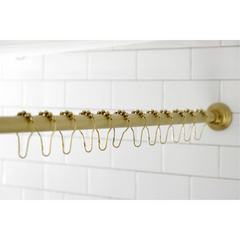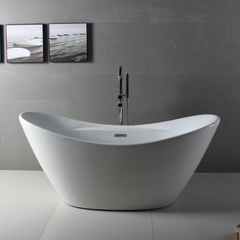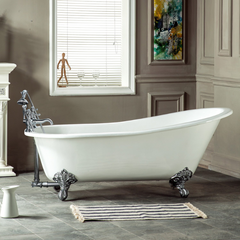Get PRO Pricing
Get [PRO] Pricing

The shower and bathtub are one of the few main focal points in bathroom design. The look of a shower or tub can make or break the room’s overall aesthetic, so paying attention to the little details is crucial. Ceiling supports are an interesting detail to use to obtain a unique design. They serve as a sturdy base for curtains, which can help to keep water and soap scum off of the floor and walls. Ceiling supports can also help to define the space of a shower or bathtub, making your washroom feel more private and inviting. There are many different types of ceiling supports available, so you can choose the perfect one for your bathroom. In this article, we will discuss the different aspects of ceiling-supported shower curtains, and which type is right for your specific bathroom. We will also provide information on the different weight capacities for each type of support.
Ceiling-mounted shower curtain supports are brackets that are installed directly into the ceiling to support hanging shower curtains. They are available in a variety of shapes, sizes, and colors. The most common shapes for ceiling-mounted shower supports are:

When choosing a ceiling support, one factor to consider is the distance from the wall for mounting. If your bathtub is close to a wall, you will need a ceiling support that is designed for close-mount applications and vice versa. The type of shower curtain ceiling support you choose will depend on how you want to enclose the space. If you want a completely enclosed space, you will need a ceiling support that encompasses the entire shower or tub area, such as a rectangular or D-shape support. If you prefer partial curtain coverage, an L-shape or straight rod might be the way to go. Commonly, the mounting rods are able to be cut for precise measurements if you’re unable to find the exact size to fit your design. By considering these factors, you can choose the right ceiling support for your bathroom and create a functional space without compromising style.

Another factor to consider before installing your shower curtain ceiling rod is the shape of your bathtub. There are two main types of bathtub shapes that can utilize ceiling-mounted shower curtains. One type is a freestanding tub that is placed anywhere in the room and is not attached to any walls. Another type, a more traditional style tub that commonly uses ceiling supported curtains is a clawfoot or pedestal bathtub.
To pair with the shape of the bathtub, the ceiling supports have their respective shapes. Freestanding tubs can use all round, rectangular, L-shape, and D-shape supports, and are ideal for placing anywhere in the bathroom without limitations. Clawfoot and pedestal bathtubs, similar to a freestanding tub, can pair with any shape of ceiling support, however, round supports are the most recognized and traditional style choice.

A traditional tub that pairs perfectly with ceiling shower curtains is our Aqua Eden 67-inch Cast Iron Clawfoot Bathtub.
Shower curtains are an important part of bathroom aesthetics. They can help to add color and style to the room, and they can also help to divide the room visually. When choosing a shower curtain keep in mind the style you’re going for and the type of bathtub you’re working with. Even though the shower or bathtub is the main fixture, the length, fabric, patterns, or colors of the shower curtain can be adjusted to your preferences for a truly one-of-a-kind bathroom. The best materials to use for shower curtains are waterproof and mold-resistant as they are exposed to water and moisture on a regular basis. Vinyl, polyester, and polyurethane are all common textiles used in this wet environment. Vinyl and Polyurethane are affordable options that still prove to be easy to clean and maintain, while polyester is a soft luxurious wrinkle-resistant choice.

The best length for a shower curtain is floor-length, so it will help to prevent water from splashing out of the shower and onto the floor. The fabric, pattern, and color of your shower curtain are a matter of personal preference. However, you may want to choose a shower curtain that coordinates with the other elements in your bathroom. Pick light or neutral colors to maximize visual space or pick a bold pattern to showcase an enriched complex sense of style.
The weight capacity of a ceiling support is the maximum amount of weight that it can safely support, and it’s important to choose one that has a weight capacity sufficient for the weight of your specific shower curtain and curtain rings. Be sure to choose a ceiling support that is made from durable materials such as brass, and a big enough size to accommodate the length and weight of the shower curtain. Also, be mindful of the number of curtain rings you’ll need to add to the ceiling support to hold the curtain.
It’s important to know the weight limits on ceiling-mounted shower curtains for safety reasons. If a ceiling support is overloaded, it could collapse, which could cause serious injury. The weight capacity of a ceiling-mounted shower curtain support can vary depending on several factors, including the type of mounting hardware used, the strength of the ceiling structure, and the quality of the materials used in the support system. In general, most standard ceiling-mounted shower curtain supports are designed to hold lightweight shower curtains and should be able to support the weight of a typical shower curtain without any issues. However, if you plan to hang heavy or decorative curtains, or if you anticipate placing additional weight on the curtain rod, such as a shower caddy or other accessories, ensure that the support system is appropriately installed.
For more precise information on weight capacity, it's best to consult the manufacturer's specifications or guidelines for the specific ceiling-mounted shower curtain support you are using. They should provide recommendations on the weight limit and any other considerations for safe installation and usage. If you're unsure, it may be wise to consult a professional or seek assistance from someone with expertise in home improvement or plumbing to ensure the shower curtain support is installed properly and can handle the desired weight. The following are general weight guidelines for different types of ceiling supports:

Install the ceiling support according to the manufacturer’s instructions for accuracy and utmost safe practices. Only hang the weight of your shower curtain and curtain rings on the support to avoid overloading the rod. Also, inspect connection points regularly, and replace them if there are any signs of damage. By following these tips, you can help to ensure the safety of your ceiling-mounted shower curtain as well as its longevity.
In conclusion, when it comes to bathroom design, the shower and bathtub play a significant role in setting the overall aesthetic of the space. Paying attention to details, such as the type of curtain support, is crucial in creating a unique and functional bathroom. Different shapes of ceiling supports, such as L-shape, D-shape, round, and rectangular, cater to specific bathtub types, such as freestanding tubs, and clawfoot bathtubs. By considering these factors, you can select the ideal ceiling support that complements your bathtub shape and enhances the overall beauty of your bathroom. In addition to ceiling supports, selecting the right shower curtain is equally important. When installing the ceiling support and shower curtain, follow the manufacturer's instructions and consider weight capacity for the best outcome. By paying attention to these details and making informed choices, you can create a visually appealing and practical bathroom space that reflects your personal style. Whether you prefer a minimalist, modern design or a more traditional and luxurious ambiance, the shower curtain and ceiling support serve as essential elements in transforming your bathroom into your own personal haven.